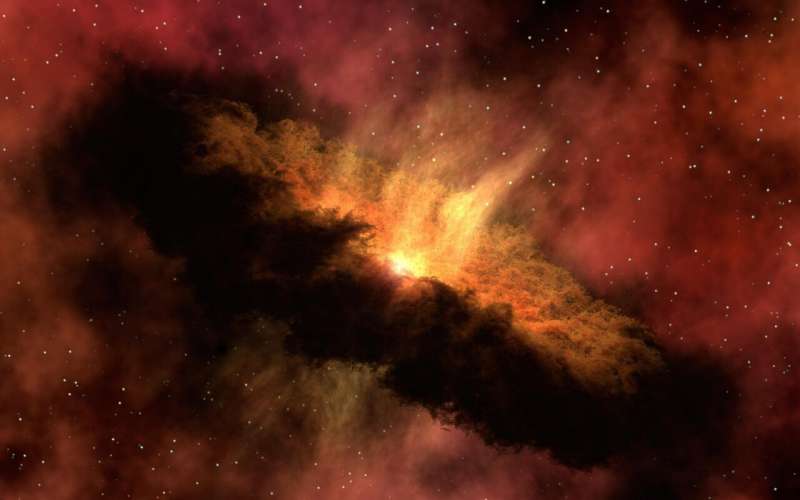This article has been reviewed according to Science X's editorial process and policies. Editors have highlighted the following attributes while ensuring the content's credibility:
fact-checked
trusted source
proofread
Astrophysicist explains science behind once-in-a-lifetime nova outburst that will light up the sky this year

The total solar eclipse isn't the only reason to keep your eyes to the sky this year. For the first time in 80 years, a star system 3,000 light years away will be visible to the naked eye thanks to a once-in-a-lifetime nova outburst.
NASA announced that the nova, which will create a "new" star in the night sky, will light up the night sky some time between now and September and be as bright as the North Star. One of only five recurring novae in our galaxy, it will be visible for a week before it fades back down.
Jonathan Blazek, an assistant professor of physics at Northeastern University, says this is an exciting moment for amateur astronomers and astrophysicists alike. It's not technically a new star, just a star that is now bright enough for people to see more clearly, Blazek says, but it provides an opportunity to see and understand the cosmos in a new way.
What exactly is a nova?
"There's a broad class of these sorts of events, and they typically share the trait of having two objects, or sometimes more than two objects, close to each other, and you're transferring mass from one to the other," Blazek says. "Eventually, you build up enough mass on usually the hotter object that it ignites, in this case undergoing fusion, and then suddenly you get a very rapid release of energy so it gets much, much brighter."
The star system in question is T Coronae Borealis, or T CrB, and it contains a white dwarf and red giant, two stars that create the perfect conditions for a nova outburst.
A red giant is what happens when a star, like our sun, runs out of fuel and becomes larger and cooler, turning red instead of the white or yellow of a hot star. A white dwarf is what a red giant turns into when it runs out of even more fuel: a very compact star.
What happens when these two stars co-orbit one another is that the white dwarf steadily strips away the atmosphere of the expanding red giant.
"The white dwarf is much smaller and much more compact, so you build up a little disk of mostly hydrogen and maybe some helium as well sitting on the white dwarf," Blazek says. "Eventually enough of it builds up and basically ignites. It's not literally burning in the sense of fire; it's thermonuclear burn and you have hydrogen undergoing a fusion reaction."
As it undergoes that runaway thermonuclear reaction, the white dwarf gets hotter, bigger and brighter, making it easier for us to see it back on Earth. This entire process is part of the natural lifecycle of these stars and why they happen every 80 years. After a white dwarf like this goes nova, it goes back to stripping gas away from the red giant, building up gas at the same rate before eventually another outburst occurs.
Outside of the novelty of these novae,, Blazek says systems like T CrB are particularly interesting for astrophysicists because they are prime candidates for Type 1a supernovae, even larger stellar explosions that are integral to mapping the cosmos.
When a star like T CrB's white dwarf hits a certain mass after repeated novae and it can't support its own mass, it starts to collapse and erupts into a massive, bright explosion, known as a supernova. Novae occur every 80 years, but supernovae are one-time events because they are so powerful that they end up destroying a star. Type 1a supernovae are even more notable because they seem to always have the same brightness, which means they likely always happen to stars of the same mass, Blazek says.
"These are cosmologically super interesting because you can see them really, really far away, and because they're almost always the same brightness, you can use them as very particular probes of the universe," Blazek says. "You can basically map out how bright something is at different distances away and use that to say, "How is the universe changing at different distances?" This is actually how they discovered dark energy."
This is why organizations like NASA and astrophysicists across the globe will likely be pointing countless telescopes at the sky to monitor this nova, Blazek says.
"We're at the stage where we have discovered dark energy using the supernova, but if we want to go to the next level of precision, we need to do a better job of really understanding deep down what these things are, how much variance there is between different objects and things like that," Blazek says.
As for the rest of us, looking up into the night sky and seeing a new source of light in the night sky will be enough. Luckily, it's so bright that this might be one of the few times where city dwellers might have an advantage when it comes to stargazing.
"Obviously, you'll get a better view if you go somewhere dark, but if you go somewhere dark, you'll see a lot of stuff up there," Blazek says. "If you want to have an easier time finding it, stay somewhere bright and then you can only see the really bright stuff, so it'll pop out behind the Boston glow."
Provided by Northeastern University
This story is republished courtesy of Northeastern Global News news.northeastern.edu.





















